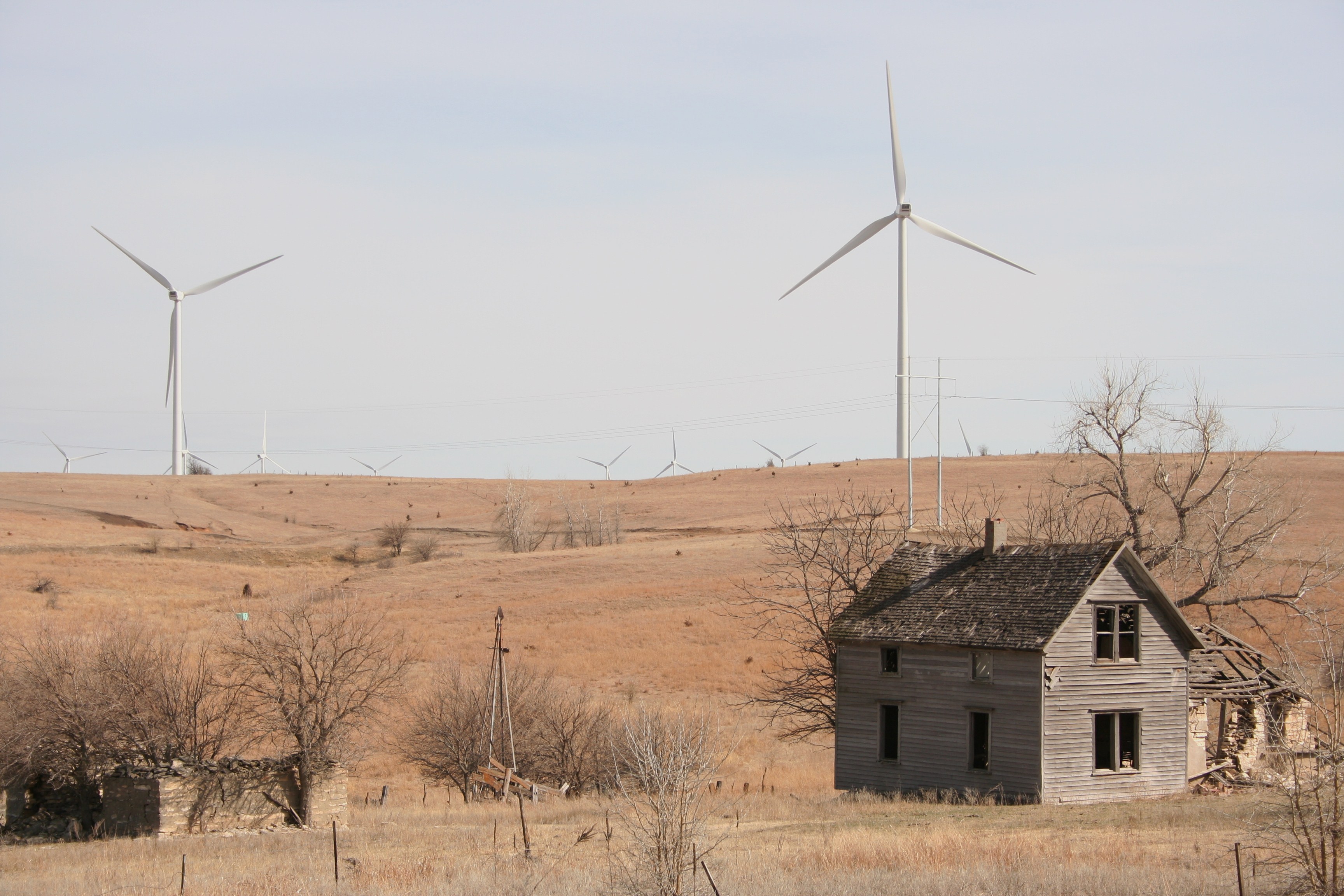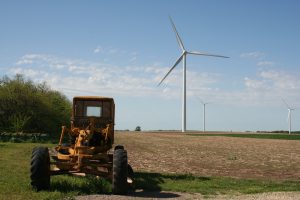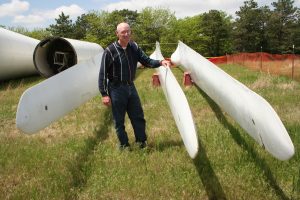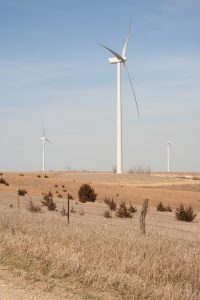What New England Can Learn From Kansas About Creating A Wind Energy Economy

Abandoned farmhouse with turbines in background. Meridian Way Wind Farm, Cloud County, Kansas. Photo by Phil Warburg
New England’s wind energy world changed dramatically this week when Denmark-based Ørsted acquired the developer of America’s first-ever offshore wind farm, Rhode-Island based Deepwater Wind. The Danish company currently has offshore wind projects in development with Rhode Island, Connecticut, Maryland, and New York. Combined, the two companies say they hope to deliver offshore wind power to seven states on the east coast by 2030 (you can read more about this deal from our collaborative stations WNPR and RIPR). The agreement is expected to be finalized by the end of the year.
But as New England invests in wind energy projects off of our coasts, the amount of wind energy we use still pales in comparison to states in the “wind belt.” One such example is Kansas.
John Dankosky spoke with Philip Warburg about what states in our region can learn from states that we don’t usually think of as leaders in renewable energy. Philip Warburg is the former president of the Conservation Law Foundation and the author of Harness the Sun: America’s Quest for A Solar-Powered Future. He wrote the article, “What Red State Kansas can Teach Blue State Massachusetts about Renewable Energy.”
Interview Highlights
These interview highlights have been lightly edited for length and clarity.
John Dankosky: What can Massachusetts learn from Kansas about wind power?
Philip Warburg: I think Kansas is a very pragmatic, very conservative state where you wouldn’t necessarily think renewable energy was taking off, but it’s really one of the leaders in the nation. Thirty-six percent of its total power generation comes from wind. And that’s not because they have some deep abiding concern for climate change, it’s because they see the economics of wind power as benefiting them. Individual ranchers and farmers who get an annuity from the wind turbines on their property worth much more than if that small amount of land was used for agricultural purposes. Local payments to help with various community projects. Retail revenues from all of the construction workers who come through and the operational staff who stay there.
And I think there’s also a sense of connection between our reliance on foreign energy sources and the wars we’ve been fighting in the Middle East. We live in a pretty protected bubble in many parts of New England where not that many people go off to fight wars in the Middle East, but in places like Kansas, that’s not the case. And one economic development chief said to me, either we have to put wind turbines on our prairie, or we have to bury our children beneath our prairie. So that’s a fairly stark perspective on one aspect of renewable energy’s benefits to Kansas.
And it sounds as though the argument is being made that energy independence, that you can do in a homegrown way, is something that Kansas can do by harnessing the wind. But it’s not that dissimilar from the same argument for drilling for oil in Oklahoma or drilling for natural gas in Pennsylvania or Colorado. It’s the same type of argument being made.
I don’t think there’s some higher set of values attached to wind relative to those fossil fuels, and in fact, those fossil fuels are being developed aggressively in places like Oklahoma, and actually in Kansas as well. One added benefit that this rural county in Kansas where I did a lot of research for my wind book developed was a wind technology training program at the community college. It started in about 2007 with some 5 students, today it’s got, 150 students. And they find jobs immediately on graduating from their 2-year certificate program. In fact, they’ve expanded now to include solar technology, so it’s been renamed a renewable energy technology program. Again, not something you would necessarily expect at a community college in the middle of Kansas farm country, but in fact, it provides local employment for a lot of people, including the children of farmers who can’t find gainful employment on the farm, and it’s really seen as a huge economic boon.
Kansas is a windy place, just how much windier is it than Massachusetts?
Well, it really is in what’s often called the “wind belt,” which extend from Texas on up through the Dakotas. And in virtually all of those states, you see an elevated commitment to wind power because the wind resource is so prodigious. Much more so than on land, for example, in Massachusetts. I do think that is one of the constraints that we face here. There is better wind in parts of Maine on land, in New Hampshire on land. Not so much in Connecticut or Rhode Island. And we’re beginning to develop those. Although there’s a lot greater concern about view-shed protection, noise issues, etc., in our more densely settled region than there is in wide open spaces in places like Kansas or the Dakotas.
Offshore wind is every bit as strong as the wind you find blowing through the great plains, it happens to be very close to major metropolitan centers, so if we can tap that offshore wind we will be both providing a great new renewable energy resource without creating the kinds of resistance that we experienced here in New England and specifically in Massachusetts to the first proposed offshore wind farm, Cape Wind, in Nantucket Sound.

The Kocher Family Ranch on the Meridian Way Wind Farm in Cloud County, Kansas. Photo by Phil Warburg
But there’s always going to be a cap here in the Northeast, isn’t there? There’s always going to be only so much land and offshore land that we can harvest the wind on.
Well if you actually take offshore into account, I’m not sure that limit is so clear. And if you combine various forms of renewable energy, we’re really looking at a transformative moment, I think, in our overall electricity economy. Vermont has set its renewable portfolio standard as providing a minimum of 75 percent of all electric generation from renewables by 2032, so that’s a pretty ambitious standard. And Massachusetts actually, the legislature just in July has adopted a new standard that would get us to 50 percent reliance on renewable technology by 2045. So will we be getting all of our electricity from renewables by the middle of this century? Very likely not, could we be getting half of our electricity from some combination of wind, solar, biomass, geothermal, small-scale hydro, absolutely.
What about Massachusetts’ big investment in hydro coming from Québec?
I think that there is competition between different sources of renewable energy. We can’t think about unitary solutions. One of the mistakes that we allowed ourselves during the 20th century was to focus on a very small number of very problematic technologies, such as coal, such as nuclear. And once you build those technologies, you develop expertise in those technologies as well as an economic investment, and it makes it harder and harder to diversify. But I think what we really need to do is look at a highly diversified energy economy that doesn’t just talk about the generation of power, but it talks about the wise use of power and the integration of storage. And that’s one area where hydro actually has a significant role to play. Pumped storage is a means of capturing, for example, surplus wind power when it’s generated, or surplus solar power when it’s generated, and releasing that power at the appropriate times when there’s demand that exceeds the supply of electricity. So I think we just have to stop thinking about electricity generation as a means of producing lots of electrons. It’s a lot more complicated than that but it can be a lot more environmentally
sustainable than that.
With all of the reporting that you’ve done, the places that you’ve traveled looking at both wind and solar power what are the things that you think we can really take away at the level of public policy or mindset that perhaps get in our way when we’re trying to figure out how to make renewables even more part of the mix in New England?
If we took a longer historical view of the New England landscape, and I mean that quite literally, we might be more forgiving of the introduction of technologies like wind and solar. If you look at New England’s landscape during the 19th century, it was largely a farmed landscape. We now have reforested New England because farming just doesn’t make that much economic sense on a large scale in New England, and we can’t compete with places like Kansas. So we’re very attached to thinking of New England as pristine forests, when in fact they’re not pristine forests. So we don’t want to compromise that visual beauty for the sake of renewable energy. I think we have to think in a more expansive way about what it means to integrate renewables into our landscape. So it might mean more wind turbines, for example, in the Berkshire Mountains or in the White Mountains or in parts of Maine. And I think we can also learn from Kansas in looking off of our shore and saying well actually we can develop wind power on a very large, you could say industrial, scale without creating the kind of reactions we got from vacationers on the Cape and in Martha’s Vineyard to the Cape Wind project.
This is an edited interview from the October 11, 2018 episode of NEXT. You can listen to the entire show right now. Find out when NEXT airs throughout all of New England.


